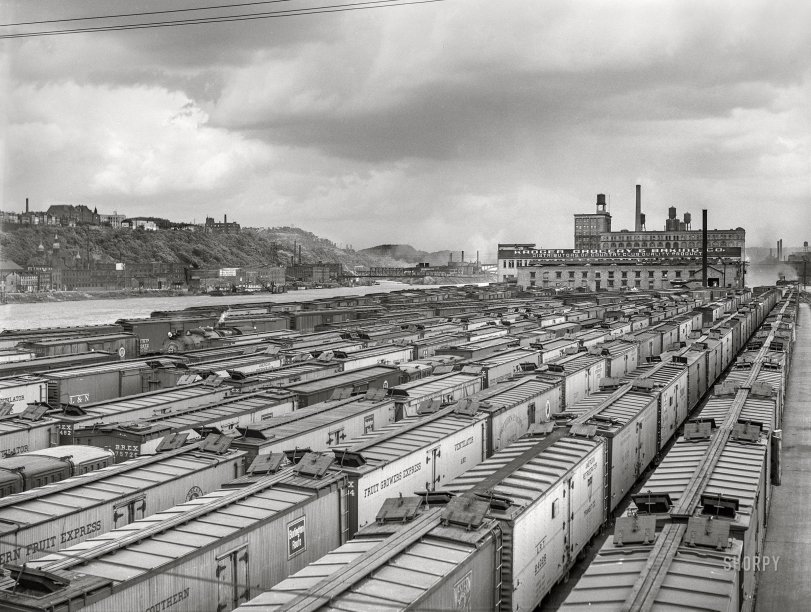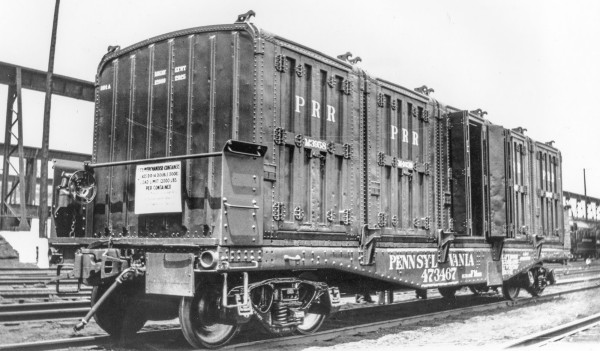


Framed or unframed, desk size to sofa size, printed by us in Arizona and Alabama since 2007. Explore now.
Shorpy is funded by you. Patreon contributors get an ad-free experience.
Learn more.

- Exclusive pump
- Details, Details
- What's that building to the left of the tower?
- Coal Barges
- Bromo-Seltzer
- Inner harbor
- The Basin
- What a headache!
- Giant stepladder?
- Baldwin 62303
- Baldwin VO-1000
- Cold
- No expense spared
- Tough Guys
- Lost in Toyland
- And without gloves
- If I were a blindfolded time traveler
- Smoke Consumer Also Cooks
- Oh that stove!
- Possibly still there?
- What?!?
- $100 Reward
- Freeze Frame
- Texas Flyer wanted
- Just a Year Too Soon
- WWII -- Replacing men with women at the railroad crossing.
- Yes, Icing
- You kids drive me nuts!
- NOT An Easy Job
- I wonder
Print Emporium
Kroger Depot: 1941

June 1941. "Carloads of fruit and vegetables at terminal. Pittsburgh, Pennsylvania." Medium format acetate negative by John Vachon for the Farm Security Administration. View full size.
One of These Cars is Not Like the Others
Among all these boxcars are a couple of oddballs. Roughly centered in the image there is a car that looks like five modules with lifting hooks on the roof. Three cars behind there is another that we can see more clearly (far left lower in the photo). What is that?
Edit: my question crossed with the answer below; thanks Rob.
I found a clear photo of one of these Pennsylvania RR FM flatcars carrying the DD1 containers:

Early container on flatcar.
On the fifth track from the right are two cars of PRR containers that were put into operation in the early thirties. The idea was to pull LTL freight from the highways and back on the rails. It was a good idea that proved to be impractical. The biggest problem was persuading connecting lines to build the terminals needed to handle the containers. The Great Depression affected freight traffic on all railroads and after ten years or so the little containers were repurposed into tool sheds and line-side electrical cabinets.
re: Reefer roof hatches
These would be empty cars or cars about to be emptied. The hatches are open to dry out the car. You would not be icing cars at their destination. I assume this is a canning plant that gets fruits and vegetables from the West.
Camera Position
Photographer was standing on the 16th Street Bridge looking northeast up the Allegheny River.
Reefer roof hatches
The roof hatches are opened to circulate cold air across the load, and to cause the ice to melt, to release cold (actually absorb heat). Salt was also frequently sprinkled on the ice in the "bunkers" so it would melt faster, releasing more cold air. The melted saltwater was drained next to the rails, which is why railroads used to run annual work trains to spray oil on the sides of the rails, to reduce rail and spikes rusting from all that salt water. The oil then combined with traction sand and cinders to make a gunky mess that you never see these days.
Other techniques frequently used were a circulating fan, belt driven from an extended car axle end, and top icing, ie blowing chipped ice on top of the fruits or vegetables.
Meat reefers were entirely different, they had monorail tracks under the roof to handle hanging sides of beef or pork. The tracks connected to tracks at the warehouses and packing plants.
The railroads had massive ice making plants spaced along the line, (100 or so miles) with elevated platforms to allow sliding the heavy ice blocks into the bunkers without having to lift them. Workers at the ice platforms also handled adjusting the roof hatches for temperature regulation, sprinkling salt on the ice, and refreshing the top ice when specified. I remember the big NKP ice plant in Bellevue Ohio.
It was all very complex, and employed many people.
Things that are still there (sort of)
The bluff across the river is known as Troy Hill. The cluster of dark brick and light stone buildings on the left of the bluff is definitely the old North Catholic High School. The school has moved to the affluent suburbs of Butler County, but the buildings remain and houses a charter school.
The darker buildings farther to the right on the bluff is most likely the church and school of Most Holy Name of Jesus parish, but I can't find any good photos to confirm my guess.
I Found The Locomotive!
It was hiding among the fruit cars.
Refrigerated Boxcars
Can you imagine the amount of ice needed for those cars.
Not your father's Strip District
The Strip District is much different than Sewickley likely remembers it. This site shows just how much the area has changed over the years. Primanti's is still there, though, and surviving the pandemic quite well.
The second picture shows the old Kroger warehouse and the upscale apartment building that is there now.
In the Strip District
Pittsburghers know the Strip as the place to find the best cheese, coffee, pasta, meat, pizza, sandwiches -- just about anything you can eat and some things you can't eat. I'm getting homesick just thinking about it.
























On Shorpy:
Today’s Top 5